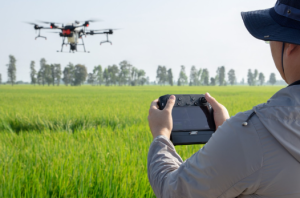The involvement of drones in agricultural practices has transformed the way farmers manage their crops in recent years. Drones have proven to be highly efficient in monitoring and applying essential inputs like fertilizers, pesticides, and water. Farmers can significantly optimize crop management by utilizing drone technology, leading to improved yields and reduced waste.
Farmers must understand how to maximize their efficiency in input application to fully harness the potential of drones. By gaining insight into best practices and effective strategies, farmers can enhance their productivity and resource management, leading to more sustainable and profitable farming operations.
What Role Do Drones Play in Modern Farming?
Agricultural drones, also known as unmanned aerial vehicles (UAVs), are equipped with sensors and cameras that capture data and perform essential tasks for modern farming. A 2023 study by the International Food Policy Research Institute (IFPRI) found that farmers using drones for fertilizer and pesticide application reported an average reduction of 30% in input usage compared to traditional methods.
These drones help in various operations, ranging from surveying large areas to applying precise amounts of fertilizers and pesticides, offering numerous benefits for input application. They enable precision application, reducing waste and ensuring crops receive necessary nutrients, while also saving time and labor by quickly covering large areas and enhancing data collection through advanced sensors that gather detailed information on crop health, soil conditions, and pest presence, ultimately aiding in more informed decision-making.
How to Maximize Efficiency in Input Application Using Drones?
By following these steps, farmers can significantly enhance the efficiency of input applications.
Selecting the Right Drone
Choosing the appropriate drone is important for efficient input application. Consider factors such as payload capacity, battery life, and durability. The DJI Agras T50 is a popular choice for agricultural applications due to its advanced design and features adapted to farming needs.
By selecting the right drone, farmers can ensure precise and effective input application, leading to improved crop yields and reduced waste. With the right tools, farmers can take their agricultural operations to new heights.
Conducting Pre-Flight Planning
Conducting thorough pre-flight planning is necessary, involving mapping the area, setting objectives, and considering weather conditions to ensure optimal flying conditions and avoid disruptions, guaranteeing a successful drone-assisted input application.
Utilizing Advanced Sensors and Cameras
Drones equipped with multispectral and hyperspectral sensors can provide valuable data on crop health, soil conditions, and pest presence. This data is vital for precision agriculture, allowing farmers to apply inputs exactly where needed.

Optimizing Flight Patterns
Efficient flight patterns are vital for maximizing the effectiveness of drone applications. Use overlapping flight paths to ensure full coverage and avoid missing any areas. Advanced drone software can assist in planning these patterns for optimal efficiency.
Implementing Variable Rate Technology (VRT)
Variable Rate Technology allows drones to apply inputs at varying rates based on real-time data. This ensures that different areas of the field receive the precise amount of inputs required, optimizing resource use and improving crop yields.
Monitoring and Adjusting Applications
Continuous monitoring and real-time adjustments are key to maximizing efficiency. Use drone data to make immediate changes to application rates and patterns, ensuring that inputs are used effectively and efficiently.
How to Overcome Common Challenges in Drone-Assisted Input Application?
Drone-assisted input application offers multiple benefits, but farmers may face challenges that hinder their success. Here are some common obstacles and solutions to overcome them:
Regulatory Compliance
Understanding and adhering to local regulations governing drone use in agriculture is important. This includes obtaining necessary licenses and following safety guidelines to avoid legal issues and ensure safe operations.
Technical Difficulties
Technical challenges, such as drone malfunctions or data processing issues, can hinder efficiency. Investing in high-quality drones like the DJI Agras T50 and ensuring regular maintenance can mitigate these issues.
Data Management
Managing and interpreting the vast amount of data collected by drones can be overwhelming. Utilizing advanced software for data analysis and visualization can help farmers make sense of the data and apply it effectively.
The Future of Drones in Agriculture
As drone technology continues to advance, its role in agriculture is expected to grow. Innovations such as artificial intelligence and machine learning will further enhance the capabilities of drones, making them even more valuable tools for modern farming.
FAQs
What are the benefits of using drones in agriculture?
Drones offer numerous benefits, including precision input application, time and labor savings, and enhanced data collection for informed decision-making.
How do I choose the right drone for my farming needs?
Consider factors such as payload capacity, battery life, durability, and specific features tailored to agriculture. The DJI Agras T50 is an excellent choice for its vital design and advanced capabilities.
Are there any legal considerations for using drones in agriculture?
Yes, it is important to comply with local regulations, obtain necessary licenses, and follow safety guidelines to ensure legal and safe drone operations.
Conclusion
Optimizing drone-based input applications in agriculture requires careful equipment selection, careful planning, and ongoing monitoring and adaptation. Using advanced drone capabilities, farmers can achieve enhanced precision, significant time and resource savings, and ultimately, improved productivity and sustainability. This results in reduced waste, minimized environmental impact, and increased crop yields, further determining drones’ potential in sustainable agriculture.